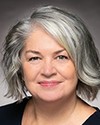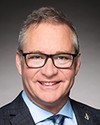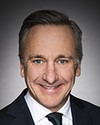As you know, the plan is to provide high-speed Internet access to all Canadians by 2030.
That's good to hear, because you will no doubt help us get there.
Stargaze?
Evidence of meeting #4 for Industry, Science and Technology in the 43rd Parliament, 2nd session. (The original version is on Parliament’s site, as are the minutes.) The winning word was satellites.
A recording is available from Parliament.
Liberal

Emmanuella Lambropoulos Liberal Saint-Laurent, QC
As you know, the plan is to provide high-speed Internet access to all Canadians by 2030.
That's good to hear, because you will no doubt help us get there.
Stargaze?
Vice-President, Satellite Government Affairs, Space Exploration Technologies Corp.
Starlink.
Liberal

Emmanuella Lambropoulos Liberal Saint-Laurent, QC
Okay, Starlink.
I think you already have the infrastructure to provide high-speed connectivity in rural areas.
How do you prioritize regions? How do you decide which areas will be served first?
Vice-President, Satellite Government Affairs, Space Exploration Technologies Corp.
That's a great question.
At this point in the early development of our system, the biggest determining factor is where there are enough satellites in view. It's determined by our constellation architecture. Then as we keep launching, we'll have a point where we can serve all of Canada. Right now we're just starting in the beta program from Friday along the U.S. and Canadian border. It's just along the northern part of the U.S. and the southern part of Canada. We want to expand that as we continue to launch more rockets with more satellites in them.
It's a subscription service. You sign up online. We'll be taking customers as we continue to grow the programs from across our coverage area.
Liberal

Emmanuella Lambropoulos Liberal Saint-Laurent, QC
You said you launched the program on Friday.
How long do you expect it to take?
Vice-President, Satellite Government Affairs, Space Exploration Technologies Corp.
That's correct. We sent out invitations to those who had signed up online at starlink.com a couple of months ago who said they were interested. We sent out some invitations on Friday to our first Canadian candidates. We already have a couple of orders.
We also sent equipment the day after we got our ISED licence to support some specific projects. For example, one of them is the Pikangikum First Nation community in Ontario which is a remote community that really struggled with broadband access for some time and had very few options. We've been working with the community and the community leaders and expect to connect the community by the end of November.
Liberal

Emmanuella Lambropoulos Liberal Saint-Laurent, QC
I know this kind of thing is hard to predict. Our goal is to provide high-speed Internet access to all Canadians by 2030.
Do you think we can get there before that?
Can we count on your company to help us get there?
Vice-President, Satellite Government Affairs, Space Exploration Technologies Corp.
We certainly think Starlink is going to be a big help in reaching places that otherwise aren't attractive for terrestrial buildout, or are too rugged to reach with terrestrial buildout. We think we will be a big part of that. I don't think satellite broadband is going to be an enormous part of Canada's existing 33 million broadband users, but it will be a contributing factor to it. We absolutely are standing ready to help those Canadians that are least connected.
Liberal

The Chair Liberal Sherry Romanado
Thank you very much.
Mr. Champoux, it is your turn. You have two and a half minutes.
Bloc

Martin Champoux Bloc Drummond, QC
Thank you, Madam Chair.
I'd like to rephrase the honourable member's question.
Ms. Cooper, if we asked you to provide coverage to as much of Canada as possible, including the more remote areas, how long would it take before the service was up and running?
Would it take a couple of years or quite a few?
Vice-President, Satellite Government Affairs, Space Exploration Technologies Corp.
I believe it will have coverage for all of Canada by 2022, and then add capacity to serve additional users. Once we have enough satellites to cover geography, every satellite after that adds capacity to add more users.
Bloc

Martin Champoux Bloc Drummond, QC
Would you say the Canadian government's targets are a bit modest, that they could be more ambitious in light of the available technology?
Vice-President, Satellite Government Affairs, Space Exploration Technologies Corp.
I can only speak for our development. We're moving as fast as we can. We feel the urgency that Canadians feel. We're really gratified to hear so many positives and enthusiastic comments in the public CRTC docket for one of our licences and expressions of interest afterwards. We're moving as fast as we can, and we're coming soon.
Bloc

Martin Champoux Bloc Drummond, QC
Thank you, Ms. Cooper.
My next question is for Mr. Goldberg.
As we know, 5G technology is being rolled out gradually. It's a topic that comes up regularly from various angles. The technology will lead to download speeds that are 200 times faster. Obviously, that won't be the case across all regions.
How can satellite technology keep pace with growing data transmission speeds in urban centres, where 5G technology will be available?
President and Chief Executive Officer, Telesat
I would say that 5G is a major part of our business investment thesis. As you say, 5G requires much more capacity to deliver the speeds that it promises to deliver, but you need to connect the towers. The towers have to be connected back to the Internet backbone with a big pipe. That's been one of the real constraints on rolling out high-capacity wireless services in more remote and rural areas.
Our LEO constellation is going to bringing big pipes to those towers and enabling a 5G rollout on the edge of the network to rural and remote communities.
Liberal

The Chair Liberal Sherry Romanado
Thank you very much, Mr. Goldberg.
We'll now go to Mr. Masse.
You have the floor for two and a half minutes.
NDP

Brian Masse NDP Windsor West, ON
One of the things that has been touched on is the question of what Canada needs to do with other like partners in the world for communications satellites and so forth.
Ms. Cooper, you mentioned that there's a registry, but that doesn't sound like a solid solution for the future.
Do you have any comments, Ms. Cooper or Mr. Goldberg, as to what we need to do in Parliament for that as legislators?
Vice-President, Satellite Government Affairs, Space Exploration Technologies Corp.
Almost every space agency and satellite regulator around the world is looking at what this emerging LEO environment requires to make sure that the rule sets and the expectations for responsible action translate into local rules. I've talked to the Canadian Space Agency and the ISED space group to understand their thinking. In the U.S., which is our home environment, we've been pressing all the regulatory agencies and policy agencies to expect more of their operators and to set higher goals in their licensing applications.
One of the other things would be to improve the amount of transparency that all licensees have to show about how they're going to meet those requirements, what their plan is and how they are doing against those plans.
It's not only participating in an updated backdrop of rules and expectations but also expecting your operators to show transparency about how they're doing and what they're doing. That becomes a differentiator instead of something to keep from disclosure.
NDP

Brian Masse NDP Windsor West, ON
Mr. Goldberg, what are your thoughts on this? We can't even get Canadian citizens out of Chinese jails, let alone try to coordinate some of these things here. What are your thoughts on how Parliament—
President and Chief Executive Officer, Telesat
It's a really big issue, and both Patricia and I have spent the substantial parts of our careers grappling at the international level trying to make all actors be responsible. At the end of the day, you're dealing with countries and sovereign governments. Some of them strictly follow the rules; others thumb their noses at the rules. There are no easy answers.
ISED is very capable in this area. We participate under the auspices of the UN group called the ITU. There's a lot at stake, and there's a lot of work that has to happen there.
Vice-President, Satellite Government Affairs, Space Exploration Technologies Corp.
If I might add—
Liberal

The Chair Liberal Sherry Romanado
Unfortunately, that's the end of that round. Perhaps you'll get a chance during the next round.
Our next round of questions goes to MP Cumming.
You have the floor for five minutes.
Conservative

James Cumming Conservative Edmonton Centre, AB
Thank you.
Mr. Goldberg, it looks like we not only have a race to provide better Internet service but also a race to raise capital. How important is it to free up some of that spectrum space and your suggestion that that would assist Telesat with your future raises in capital towards your LEO expansion program?